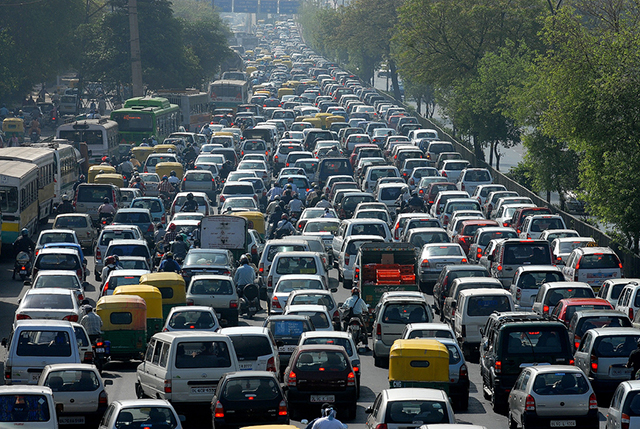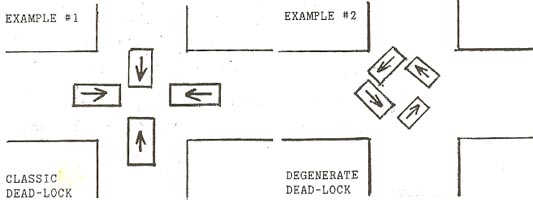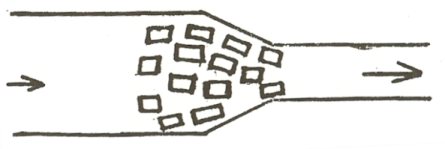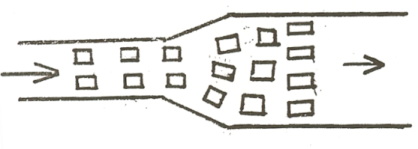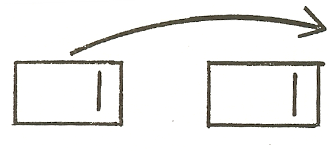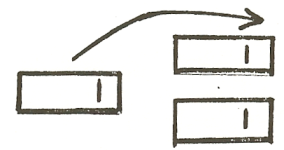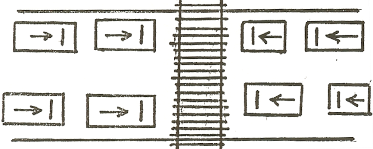As a squadron commander I had two airplanes deployed to Naples, Italy for a few years where the number one report back from the field was pilots and mechanics on the losing end of, well, vehicular mishaps. "Relax," those who knew what's what in Italy would say, "That's just how it is when driving in Italy." Indeed.
— James Albright
They gave me the definitive guide. Having read this in 1994 I thought it described driving in Italy exactly. (I got it as a copy of a copy that I was told came from one of the U.S. Naval bases in Italy.) But then I heard this was actually written in the 1950s by American Humorist Corey Ford (1902 - 1969) as published in various places. I've yet to see the article as originally published.

Updated:
2013-07-18
There is a simple method of achieving the right state of mind for driving in Italy. Before you start your car for the first time, sit in the driver’s seat, hold the steering wheel, and think the following: I AM THE ONLY DRIVER ON THE ROAD, AND MINE IS THE ONLY CAR. It may be hard to believe, especially after you have seen Rome in the first week of July, or Naples during any rush hour, but millions of Italian drivers believe it, and so can you.
An Italian driver’s reaction to any encounter with another vehicle is first, stunned disbelief, and then outrage. You don’t have a chance unless you can match this faith. It isn’t enough to say that you are the only driver, or to think it, you have to believe it. Remember, your car is THE CAR; all others are on the road because you allow them to be there.
In Italy, as elsewhere, there are laws about streets, maximum permissible speeds, which side of the street you can drive on, and so forth. In Italy, however, these laws exist only as tests of your character and self-esteem. Stopping at a stop sign, for example, is prima facie evidence that you must not be a person of real worth. Contrarily, driving through a stop sign is proof that you are obviously a person of importance to whom the ordinary rules do not apply. This is why the Italian driver who gets a ticket gets red in the face, swears, wrings his hands, beats his forehead with his fists, and this is why people come out of nearby shops to snicker and point at him; it isn’t the fine, which is ridiculously low, nor the inconvenience, for most offenses you simply pay the cop and he gives you a receipt, but the implication that he is, after all, not quite important enough to drive the wrong way down a one-way street.
Remember, therefore, signs, laws, and the commands of the Italian policeman are for the: lowly and mean-spirited. Every Italian’s dearest desire is to be an exception to the rule - any rule. The only place he can do this regularly is in his car.
The Basic rule of driving in Italian cities is: force your car as far as it will go into any opening in the traffic. It is this rule which produces the famous SICILIAN FOUR-WAY DEADLOCK, as illustrated below:
You will note in the sketch of example number two the lack of symmetry and sloppiness. This situation is generally encountered in cities North of Rome due to the lack of merit among their drivers.
Sharp study of either example may suggest that the deadlock, Sicilian or Degenerate, can be broken if any of the vehicles back up. This brings us to another important point about Italian driving; you can’t back up. You can’t back up because there is another car right behind you. If you could back up, and did, you would become an object of ridicule, for backing up breaks the basic driving rule, and suggests again that you are a person of no consequence. The impossibility of backing up accounts for some of the difficulty you will have in parking. Aside from the fact that there isn’t anywhere to park, you will find that when you try to parallel park by stopping just beyond the vacant space, and backing into it, you can’t because that fellow is still right behind you, blowing his horn impatiently. You point at the parking space, making gestures that you only want to park. He blows his horn again. You can give up and drive on, or you can get out and go back and try to get him to let you park your car. This you do by shouting PERSONAL ABUSE into the window of his car. One of three things will happen; he may stare straight ahead and go on blowing his horn (if this happens, you’re whipped, for no foreigner can out-sulk an Italian driver), he may shout PERSONAL ABUSE back at you; or he may, especially in southern cities like Naples and Palermo, where honor is all important, get out of his car and kill you, subsequently pleading DELITTO D’ONORE (crime of honor), which automatically wins in southern Italian courts.
The parking problem created by the backing-up problem creates the RIGHT HAND HORROR. At no time in Italian cities should you drive in the right hand lane. One reason is that Italians usually drive head-first into parking places. Thus, every third or fourth parked car has its tail-end sticking out into traffic, making their right lane a narrow, winding one.
Unfortunately, the center lane has its hazards, too; the right-lane drivers swerving in and out of the center lane as they steer around the sterns of half-parked and double-parked cars. Double-parked cars run one-per-block north of Rome, and two-per-block south of Rome. Italians double-park only on four-lane streets; in six-lane streets they triple-park. Right lane driving is further complicated by the Italian style of entering from a side street by driving half-way into the first lane, and then looking.
The way to deal with lane-swervers and cross-creepers is to blow your horn and accelerate around them. If you make a careful inline stop when your lane is invaded, you not only expose your inadequacies as a person, but you can never get moving again, since you have marked yourself as a weakling whom anyone can challenge with impunity. While performing these gyrations, you must honk, for all Italian drivers accept the axiom that anything you do while blowing your horn is sacred. Horn blowing, incidentally, except in cases of serious danger, is against the law in every Italian city. I mention this because you would never know it otherwise.
Remember too, that one-way streets in Italy are NOT one-way. To begin with, the driver who has a block or less to go realizes at once that when they put up the signs they were not thinking of cases like his. He drives it the wrong way, going full throttle to get it over with quickly, and to prove that he really is in a terrible hurry. More importantly, however, Italian one-way streets always have a CONTRO SESSO lane, that is, a lane for going the wrong way. It is reserved for taxis and busses, and is indeed always full of taxis and busses, producing the TWO-WAY ONE-WAY STREET, which in turn produces law suits, pedestrian fatalities, and hysterical foreign drivers.
The distinctive feature of the Italian cities is the PIAZZA - a wide space entered by as much as eight streets, in which a Bernini fountain is hidden by parked cars. Italian traffic commissioners have sensibly ordained circular traffic for most of the piazzas, but the traffic circle, with its minuet-like formality of movement is, to an Italian driver, just so much more exhilarating open space. You do not go around an Italian traffic circle; you go across it, at high speed, taking the shortest path from your point of entrance to your intended exit, while sounding your horn all the while.
All Italian driving requires, and soon produces, familiarity with the FUNNEL EFFECT. Especially in those cities that preserve medieval architecture in the downtown section (which usually means all Italian cities), you will find that four-lane streets usually, after four or five blocks, become two-lane, and then one-lane streets. Since most Italian cities are force fed with automobiles by an excellent turnpike system, this produces the FUNNEL EFFECT, and the REVERSE FUNNEL EFFECT, as illustrated below:
The funnel effect...
The Reverse funnel effect...
At first glance, it may appear that the funnel effect is more dangerous and unnerving than the reverse funnel effect. This is not correct. True, the unwary motorist entering a funnel may get trapped against one side or the other, and have to stop there until traffic slacks off around one or two o’clock in the morning, but you can usually abuse your way out of this trap. It is the reverse funnel which produces what my insurance calls death and dismemberment. Imagine the effect of bottling a number of prideful and excitable Italian drivers in a narrow street for a half-mile or so, and then suddenly releasing them. It is like dumping out a sack of white rats. As each car emerges, it tries at once to pass the car ahead of it and so on. If Italian cars were even roughly of the same engine power, this would simply produce a wild acceleration, but the cars range from 500 cc midgets up to Formula 1 racing machines, and the first hundred yards or so of the reverse funnel effect, before they shake down is a maelstrom of screaming engines, spinning tires, screeching brakes, and blaring horns.
Italian roads, just like Italian streets, change their character unexpectedly. It is not unusual to be driving on a six-lane highway, then to round a curve and find that you are driving on a two-lane sunken road of mud, with the original Roman paving stones sticking up here and there. Most roads, however, are something in between the two extremes.
The paramount feature of the Italian highway driving is IL SORPASSO. The word SORPASSARE means both to pass with an automobile, and to surpass or excel. To SORPASSARE someone is to excel him socially, morally, sexually, and politically. By the same token, to be SORPASSATO, is to lose status, dignity, and reputation. Thus it is not where you arrive that counts, but what (or whom) you pass on the way. The procedure is to floor your accelerator and leave it there until you come upon something you can pass. If IL SORPASSO is not immediately available, settle in its wake at a distance of six to eight inches and blow your horn until such time as you can pass. Passing becomes possible, in the Italian theory, whenever there is not actually a car to your immediate left. For those bold spirits who decide to take up SORPASSO, I have prepared diagrams of the two basic SORPASSO techniques, below:
Sorpasso
Doppio Sorpasso
When an Italian driver sees the car ahead of him on the highway slow up or stop, he knows there can be but two causes, the driver ahead has died at the wheel, or else he has suddenly become a PERSON OF NO CONSEQUENCE, which roughly means the same thing, and is fate which in Italy hangs over every head. He therefore, accelerates at once and passes at full speed. If the driver ahead has, in fact, stopped for a yawning chasm, the passer is done for; but more often the first driver has merely stopped for a railroad crossing gate. The same thing, naturally, is happening on the other side of the gate, and the result is the CROSSING DOUBLE CROSS, or RAILROAD IMPASSE, as illustrated below:
The instant the gate goes up, all four drivers obey the law of occupation of empty space, and four cars meet in the middle of the tracks, followed closely by the cars tailgating them. In the four-handed personal abuse that follows, the drivers of the two right-lane cars usually team up against the drivers of the two left-lane cars, but this is by no means a rule. Sometimes the three most expensive cars team up against the cheapest car, sometimes all four fall upon the crossing guard.
In Italy, you will see bigger trucks than you have ever seen in your life. Huge, eight-axle double-semis with cabs seating four abreast. There are not special speed limits for trucks in Italy. As if the very sight of those things were not terrifying enough, the drivers often paint notices across their cabs, just above the windshield, usually religious. It is nerve shattering to meet one of these monsters coming downhill at fifty miles an hour on a narrow mountain road, but panic looms if you See “God Is Driving” written on the cab, while “Heart Of Jesus Help Me” doesn’t bear thinking about.
It is gauche to be a pedestrian in Italy. It is in bad taste. A pedestrian is a PERSON OF NO CONSEQUENCE. The Italian pedestrian feels ashamed, and does everything he can to avoid acting like a pedestrian. To cross the street on the crosswalk, for example, would be to admit that he is a pedestrian, so he crosses in the middle of the block, strolling slowly through the traffic; he is trying to make it clear that he is not a pedestrian at all, but a driver who has momentarily alighted from his car.
If you treat him like a pedestrian, thus drawing attention to his shame, he will be furious. Do not look directly at him. Do not drive around him. Above all, do not stop for him! If he challenges you, drive within four inches of his toes as if he were not there. Of course, if you drive ON his toes, he will become an INJURED PARTY, which in Italy outranks even a Ferrari driver, and he will shout PERSONAL ABUSE, and call a cop.
The Italian word for an automobile collision is L’INVESTIMENTO. When you are involved in a collision (notice I do not say ‘if’ but ‘when’), you will first wonder what you should do. Sit tight until a cop arrives? Call the consulate? Start bribing witnesses? Don’t worry. The aftermath of L’INVESTIMENTO, providing there is not serious injury, is as formal as the figures of a quadrille, simply follow your partner. First, all drivers and passengers spring from their cars shouting PERSONAL ABUSE. Passersby spring from their cars. Pedestrians, hopeful of being taken for a motorist, act as if they have been the principals in the crash. Stores empty as shopper join the crowd. Invalids totter from their beds for blocks around to come to the scene, shouting and gesticulating. Do not be afraid of this crowd, even if you are utterly and absolutely in the wrong. Half of these people are on your side, simply because the other half are against you. If a priest has blamed you, the communists become your partisans. If a rich man should point out that you were, after all, dead drunk and driving up on the sidewalk with your eyes closed, any man with calluses on his hands will swear he has know you as a teetotaler for many years. All this blame and praise is unimportant, however, mere rhetoric. In an Italian collision, blame has, nothing to do with the actions of the drivers, but is entirely a matter of status and virility. The driver of the newer, more expensive car is automatically in the right. He is, in fact, an INJURED PARTY. Any car naturally outranks any scooter, and any sports car outranks any family car not chauffeur driven. This seems simple, but can become complicated. For example, does a brand new Fiat 127 outrank a two-year old 850? What are the odds as between a ten-year old Porsche and a Mercedes that needs washing? As if these and similar questions were not enough, the bearing and dress of the drivers becomes an additional factor. If one driver is in a suit and the other is accompanied by a blond over five-foot seven. If one has a calling card and the other has not, the balance can shift in an instant. If both have calling cards, it becomes a contest of titles.
Do not be distracted by all the shouting about what has happened ... Who cares what happened? That’s over. What matters is what is happening now the contest of dignities. You are being watched by hundreds of eyes, alert to the slightest loss of poise. Hundreds of lips are waiting to snicker at your first retreat from savage indignation. But you can win. As you stand there in your wilted nylon shirt, comprehending nothing, groggy with cross city driving, bilious with the change to your diet, your children shrieking in your dust-covered station wagon, your wife in tears with fright, you can win! Just keep telling yourself,
“I AM A PERSON OF CONSEQUENCE, I AM,..... , I AM....,”

